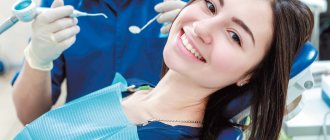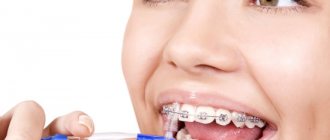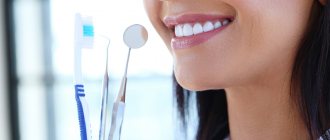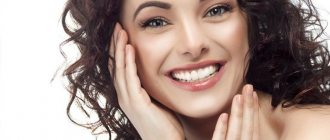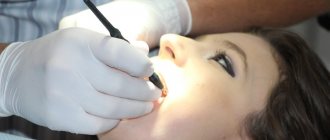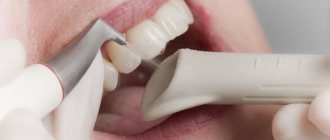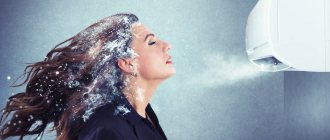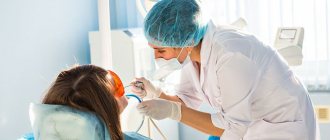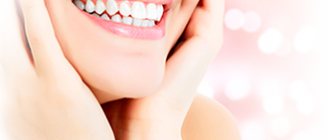Oral hygiene is an important component of the health of the whole body. Many people neglect brushing their teeth twice a day, carrying out this procedure only in the morning. However, professional dentists say: in order to prevent caries and protect the oral cavity from the growth of harmful bacteria, it is necessary not only to brush your teeth twice a day, but also to do it correctly. Let's Let's look at a few basic points in the process of brushing your teeth that will help you keep your mouth clean and keep your teeth and gums healthy.
How many times a day should you brush your teeth?
As we noted earlier, you need to brush your teeth at least twice a day - in the morning and before bed. Professional dentists recommend paying more attention to the evening procedure.
Brushing your teeth before bed is necessary to prevent tooth decay: the food you eat during the day settles on your teeth in the form of plaque and at night promotes the proliferation of harmful bacteria. This can lead to gum inflammation and tooth decay.
The morning routine of brushing your teeth can be done before or after breakfast. However, if you have eaten juice or fruit, you should wait an hour before brushing your teeth. The acid contained in these products softens the enamel and you risk “cleaning out” useful minerals from it.
Causes of plaque and tartar
The formation of dental plaque occurs unnoticed. First, it is a thin film consisting of bacteria and their metabolic products. Poorly cleaned food remains serve as a breeding ground for microorganisms. Over time, the film becomes denser, an acidic environment is formed under it, and this contributes to the destruction of enamel and the occurrence of caries. Tea, coffee and tobacco cause the plaque to become dark in color.
Gradually, plaque mineralizes, that is, hardens, turning into plaque and then into tartar. Its color is yellowish, but you can find stones of brown, black, and red color. Coloring depends on the level of oral hygiene, nutrition, and bad habits.
The causes of tartar formation include:
- improper brushing technique;
- unsuitable toothpaste or brush;
- smoking;
- insufficient chewing of food;
- uneven teeth;
- chewing on one side;
- presence of braces, bridges, crowns;
- deviations in the functioning of the endocrine system.
Depending on the location, tartar can be subgingival or supragingival. When located subgingivally, the stone is brown or black in color; it cannot be detected independently; this can only be done by a specialist using a dental probe. Typically, stones of this type are found in older people.
Supragingival stones are easy to see without any devices: they are yellow or white deposits, most often found on the front teeth.
It is impossible to remove dense plaque and tartar on your own using normal hygiene procedures.
Toothbrush hardness
The stiffness of the brush is determined by the diameter of the fiber - the larger it is, the stiffer the brush will be. Nowadays, manufacturers often indicate the degree of hardness on packaging: very soft (ultra soft, extra soft), soft (soft), medium (medium), hard and very hard (hard).
Very soft brushes are suitable for children under 5 years old and people with sensitive teeth. Soft brushes - for children from 5 to 12 years old, as well as for severe pain in the teeth and gums. Medium hardness brushes are suitable for children over 12 years old and adults.
Hard and very hard brushes are not recommended for use without consulting a doctor. Such brushes can injure the gums and cause abrasion of the hard tissues of the teeth.
Abrasiveness of toothpaste
Abrasiveness is considered an indicator of the ability of toothpaste to disrupt the structure of enamel and dentin due to abrasion.
The abrasive substances in the paste are responsible for this indicator: silicon compounds, silicon dioxide, hydrated silicon dioxide, or calcium carbonate and calcium phosphate compounds.
A high degree of abrasiveness, although it contributes to high cleaning power, but at the same time causes more damage to tooth enamel. There are 4 levels of toothpaste abrasiveness:
- Low level of abrasiveness - RDA 0-70. Recommended for children and adolescents up to 12-14 years old and adults with hypersensitivity of teeth and gums. For children under 6-7 years of age, an abrasiveness of up to 40 is more suitable. Such pastes have minimal impact on tooth enamel and dentin.
- The average level of abrasiveness is RDA 70-100. This level of abrasiveness is suitable for children from 14 years of age for daily brushing of teeth. Such pastes help maintain the natural color of teeth after professional cleaning and whitening. If you have increased sensitivity of your teeth and gums, it is better to use pastes with low abrasiveness.
- High level of abrasiveness - RDA 100-150. Recommended for people over 14 years old. If you often drink tea, coffee drinks, or tobacco, then periodic use of highly abrasive paste is also suitable for you. When used occasionally and alternating with a paste of medium abrasiveness, it cleans well and does not seriously injure the enamel.
- Very high level of abrasiveness - RDA above 150. Dentists do not recommend using such pastes frequently, as they can cause serious damage to the enamel. Only a specialist can prescribe high abrasive pastes. You must brush your teeth strictly following your doctor's recommendations.
Types and methods of cleaning in dentistry
Patients are interested in how professional teeth cleaning is done. The following types of teeth cleaning are used in dentistry.
Ultrasonic cleaning
This is the most effective method of cleaning teeth in dentistry, removing hard deposits on tooth enamel. An ultrasonic scaler is used to remove stones. At its tip there is a nozzle that makes oscillating movements. Additionally, water is supplied to the nozzle. Due to the cavitation effect, the cleansing effect of the procedure increases.
Ultrasonic teeth cleaning does not damage tooth enamel. It will remove not only stone, but also pathogenic bacteria. During the manipulation, the patient does not feel pain.
Laser cleaning
The laser cleaning procedure occurs very quickly. The laser beam is directed at the surface, which leads to the evaporation of water contained in the tartar. Remaining plaque is washed off with a stream of water supplied under pressure.
Sandblasting
This removal method is carried out using an Air Flow device. This is a reliable method for removing old plaque. The dentist uses devices with attachments, mixtures with a fine abrasive substance and a fixative gel. The cleansing powder is produced with a pleasant aroma, which further increases comfort.
Chemical cleaning
In this case, a special gel is applied to the enamel. It contains organic acid and hydrogen peroxide. This mixture stays on the enamel for several minutes. Under the influence of chemicals, tartar is destroyed.
This is a painless technique. The downside is that it does not allow you to clean the spaces between your teeth.
Fluoridation
Fluoridation of enamel is carried out after removal of tartar. The procedure is carried out for the purpose of:
- strengthening enamel;
- decrease in enamel sensitivity;
- slowing down the growth of bacteria;
- reducing the negative effects of acid.
Before this method of professional teeth cleaning, they are dried so that the drug is evenly distributed over their surface. Next, the doctor applies a fluoride-containing drug to the enamel for several minutes. The enamel is then dried again. After this, the dentist treats the oral cavity with a composition containing calcium and magnesium to enhance the effect.
Polishing with paste
This procedure is performed after ultrasonic removal or after using Air-Flow technology. After polishing, the tooth enamel becomes smooth. This reduces the rate of plaque formation and consolidates the result. Polishing teeth is safe for enamel: hard tissues are not destroyed, and there are no scratches left on the enamel.
During polishing, the patient does not need to undergo anesthesia at all.
After polishing, you will need to abstain for some time from coffee, strong tea, red wine, as well as all berries that have a coloring effect. You should also stop smoking.
Alternative remedies
To more effectively clean the mouth, in addition to a toothbrush, you should use alternative cleaning products:
- Dental floss. Allows you to remove food debris in the space between the teeth, where a regular brush is not so effective. You need to use dental floss carefully so as not to damage the soft tissue. Under no circumstances should you try to replace dental floss with regular threads - they have a completely different structure and do not have an antiseptic coating.
- Interdental brushes: These brushes are best suited for large, irregular or concave tooth surfaces. To achieve the best result, the diameter of the brush should be larger than the space between the teeth.
- Toothpicks. Small wooden sticks that allow you to get rid of food debris between your teeth. You should also be careful with toothpicks so as not to damage soft tissue.
- Irrigators. A device for cleaning the space between teeth and at the junction of tooth and gum. The irrigator nozzle delivers a stream of water under a pressure of 0.7 - 4.8 bar - this allows you to wash away food debris and remove soft plaque from the surface of the teeth, gums, and oral mucosa.
Additional oral care products
Such hygiene products enhance the effect of brushing your teeth and help maintain oral hygiene in between brushings. 1. Dental floss or floss. Using dental floss helps remove food debris from between the teeth, which is not always possible even with a toothbrush. There is a wide range of flosses on sale. Their use does not take much time. 2. Mouth rinses. Such liquids are convenient to use to freshen breath, although they also have other purposes. Mouthwashes contain bactericidal substances that fight bacteria that cause various diseases in the oral cavity. You should pay special attention when choosing a mouthwash for your child, since most of them contain alcohol. Alcohol-containing mouthwashes should not be used in children. It is necessary to use mouthwash after brushing your teeth or eating food. The rinse duration should be approximately 30 seconds.
There are a large number of hygiene products that help you perform the necessary oral care. They should be used correctly to reduce the number of trips to the dental office.
Proper Teeth Brushing Technique
High-quality and safe teeth cleaning includes 4 main processes:
- cleaning the outside of the teeth with sweeping movements from top to bottom;
- brushing the inside of the teeth with vertical movements using the tip of the brush;
- Clean the chewing surface of your teeth using back and forth movements;
- massage your gums by closing your jaw and making circular movements along the surface of your teeth.
After completing the main procedures, use dental floss or another means to clean the space between the teeth.
Which brush to use
As we found out earlier, you should choose a toothbrush based on the sensitivity of your teeth. Dentists recommend using brushes with low or medium hardness.
Stiffer brushes can only be used as prescribed by a specialist and all recommendations are followed. Otherwise, you may damage the surface of your teeth and soft tissues.
Electric toothbrushes are not as effective as they might seem. They do not sufficiently clean the surface of the tooth and drive food debris into the space between the tooth and gum. It is better to opt for a regular brush with a hardness that suits you.
What paste to use
According to GOST, toothpastes are divided into hygienic and therapeutic and prophylactic. Hygienic pastes are designed for mechanical cleansing, removing food debris and plaque from enamel. Therapeutic and prophylactic products are intended for the prevention of oral diseases. Such pastes have an antiseptic and anti-inflammatory effect.
Rospotrebnadzor identifies 4 types of toothpastes:
- with fluoride content - reduce the risk of developing caries and demineralization of enamel;
- with triclosan - have an anti-inflammatory effect in gum diseases;
- having a whitening effect - help in the fight against dark plaque;
- with an anesthetic effect - reduces the increased sensitivity of teeth to sour, hot and cold.
How long to brush your teeth
To achieve the best results when brushing your teeth, you must not only adhere to the correct technique, but also brush your teeth for a certain amount of time. Professional dentists say that the most optimal time for brushing the oral cavity is 2 minutes - 30 seconds for each half of the upper and lower jaw.
By following all these recommendations, you can easily achieve oral health and visit the dentist less often, only for prevention and professional cleaning.
Occupational Hygiene Program
Like the frequency of visits, the professional hygiene program itself, its sequence and combination of procedures, is individual for each patient. The number of teeth that can be treated in one visit is also considered on an individual basis, taking into account not only the state of the dental system, but also the general somatic status and age of the person.
Roughly, the program may consist of the following procedures:
- inspection;
- local anesthesia;
- removal of dental plaque, supra- and subgingival deposits using chemical solutions or hand tools;
- final removal using ultrasound or special preparations;
- grinding and polishing of surfaces;
- fluoride varnish treatment;
- fissure sealing;
- testing teeth brushing skills [1].
